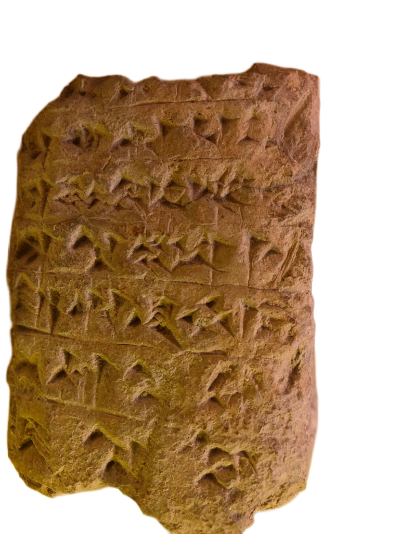This paper presents two bricks inscribed in Middle Elamite cuneiform dating to the reign of the Middle Elamite king Hutelutuš-Inšušinak (ca. 1120-1100 BCE), last king of the Middle Elamite period (Mofidi-Nasrabadi 2018, 232). The bricks are currently on public display in the Shah Cheragh Museum in Shiraz, western Iran.1
Introduction
During a visit to the Shah Cheragh in the summer of 2022, the authors became aware of two inscribed brick fragments related to three bricks previously published by Abdolmajid Arafaee in 1997. According to our information, these objects were discovered in the course of land development works on the grounds of the Shah Cheragh, specifically excavation connected to the construction of parking areas and similar. With the kind permission of Mr. Behrooz Moosazadeh, the custodian, we were allowed to document the two bricks, both incomplete and broken. The pieces clearly date to the reign of Hutelutuš-Inšušinak, confirmed by careful analysis of the Middle Elamite inscription, particularly the orthography of in-su-uš-na-[ak] and si-mu-ut along with the order of Kiririsha, Insušnak, and Simut at the end of the inscription. As three bricks held at the Shah Cheragh has previously been published as 176-1, 176-2, 176-3 (Arafaee 1997), the two artifacts edited below are numbered 176-4 and 176-5 respectively.
As the successor of Šilhak-Inšušinak and the last Middle Elamite king, (c. 1120–1100) (Malbran-Labat 2018, 473), Hutelutuš-Inšušinak was defeated by Babylonian king Nebuchadnezzar I at the river Ulāia (Gorris 2018, 250). His inscribed bricks are mostly found at Susa and Tall-e Malyan (Gorris 2018, 243), however, “some inscriptions attest Hutelutush-Inshushinak’s activities also outside of Susa at Shalukki (EKI 64) and Anshan” (Lambert 1972, 473) .
Shah Cherag Museum ŠČ 176-4
Inscribed brick fragment (P532990)
length: 114 mm
width: 64 mm


Inscription
| obverse | translation | |
| 1. | [...]⸢ša] | ... |
| 2. | ANki-ri-ri-⸢ša] | (that of) Kiririša |
| 3. | ANin-su-uš-na-[ak] | (and) Inšušinak |
| 4. | ANsi-mu-ut-me | (and) Simut |
| 5. | e-ri-en-tum-⸢ni?] | with baked bricks |
| 6. | be-ip-⸢si⸣-⸢ih] | I renovated |
| 7. | ku-si-ih | (and) built |
Commentary
On ŠČ 176-4, only seven lines of the inscription have been preserved. In the inscription the king presents himself as the builder of a temple dedicated to Kiririša, Inšušinak, and Simut. Kiririša, the “great lady” (Jahangirfar 2018, 108) or “mother of gods” (Vallat 2012) was a prominent goddess worshiped in Elam although at first was mistakenly considered the same as Pinikir (Henkelman 2008, 354). Kiririša was the tutelary goddess of the city of Liyan. She was also an important member of the pantheon of Anšan (Vallat 2012). The only known temple dedicated to Kiririša, shared with Napiriša, Inšušinak and Simut, was located in Anšan, (Potts 1999, 247) and built during the reign of Hutelutuš-Inšušinak (Henkelman 2008, 356-357; Lambert, 1972, 61-76; Reiner, 1973, 57-62). Inšušinak, one of the most prominent Elamite gods, was almost always connected to royal power and sometimes appears to form a trinity with two other Elamite deities, Napiriša and Kiririša (Jahangirfar 2018, 108). Simut (Elamite ANSi-mu-ut, ANŠi-mu-ut-ta, ANŠi-mu-ut, ANŠi-mut, ANMAN and Akkadian dSi-mu-ut) is an Elamite deity who appears directly after Inšušinak in the Treaty of Narām-Sin, the earliest known mention of Simut (Henkelman 2011, 511). The verbal form “be-ip-si-ih” is a matter of debate since although √pe “to gather” seems to be the root, Henkelman has proposed the more specific meaning of “raise a new building on the ruins of the previous one” (Jahangirfar 2015, 92) .
Shah Cherag Museum ŠČ 176-5
Inscribed brick fragment (P532991)
length: 65 mm
width: 64 mm


Inscription
| obverse | translation | |
| (broken lines) | ||
| 1. | [...] [ki?-me?] | ... |
| 2. | [...] [tuk?⸣-ANhu | hu[te]kašan |
| 3. | [...] ka4-ša-⸢an⸣ | |
| 4. | [...] pa [...] | ... |
| 5. | [...] | ... |
Commentary
The second brick which is severely damaged, preserving five incomplete lines and only one distinguishable word, “hu[te]kašan”. This word seems to be the second part of “útuk-hutekašan”, “wohl gelobt von (Gott) Hutekaša” (Hinz & Koch, 1987, 1254) which has been read as “Hutekaran” in another inscription of Hutelutuš-Inšušinak published by Arfaee (1997, 39-40). We have not been able to find this word elsewhere, however.
Notes
1 We wish to express our special gratitude to Mr. Behrooz Moosazadeh, custodian of the Shah-e Cheragh Museum in Shiraz, who allowed us to document the bricks presented here and kindly supplied photographs of the artifacts.
References
Arafaee, A. 1997. “Se Ājor Nebeshteh Dar Muze Ye Āstān-e Shah-e Cherāgh.” Farhang 37-38: 37–47.
Hinz, W., and Koch, H.. 1987 Elamisches WöRterbuch (in 2 Teilen). Teil II: I-Z. Vol. 17.
Potts, D.T. 1999 The Archaeology of Elam. Cambridge.


